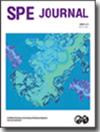大环空气油两相流摩擦系数的实验研究
IF 3.2
3区 工程技术
Q1 ENGINEERING, PETROLEUM
引用次数: 0
摘要
摩擦系数是影响准确计算井筒环空压力分布的重要因素,对钻井作业的安全具有重要意义。迄今为止,对摩擦系数的研究主要集中在低粘度液体(如水和煤油)上。因此,所得摩擦系数在气-油基泥浆两相流计算中的适用性较差。本研究报告了在大井筒环空中不同粘度(16-39 mPa·s)的油气两相流动实验,实验井为Φ100×Φ60×12 000 mm。气液混合雷诺数为500 ~ 10000。结果表明,不同流型下摩擦系数的变化趋势一致。对于相同的混合物雷诺数,液体粘度越大,不同流型间摩擦系数的变化越小。液体表面流速越大,摩擦系数越大。在对实验数据进行无因次分析的基础上,建立了大环空油气两相流摩擦系数的计算模型,与实验数据的预测误差小于30%。该研究可为钻井中油气基泥浆两相流的精确计算提供依据。本文章由计算机程序翻译,如有差异,请以英文原文为准。
Experimental Study on Friction Coefficient of Gas–Oil Two-Phase Flow in a Large Annulus
Summary The friction coefficient is an important factor that affects the accurate calculation of wellbore annular pressure distribution and is of great significance for the safety of drilling operations. To date, investigations of the friction coefficient mainly focused on low-viscosity liquids (such as water and kerosene). Thus, the obtained friction coefficients have poor applicability in the calculation of gas–oil-based mud two-phase flow. This study reports gas–oil two-phase flow experiments for different viscosities (16–39 mPa·s) in the annulus of a large wellbore, performed using an experimental wellbore (Φ100×Φ60×12 000 mm). The gas–liquid mixture Reynolds number ranges from 500 to 10,000. The results reveal a consistent trend for the variation of the friction coefficient under different flow patterns. For the same mixture Reynolds number, a larger liquid viscosity corresponds to a smaller variation of the friction coefficient among different flow patterns. The larger the superficial liquid velocity, the greater the friction coefficient. Based on the dimensionless analysis of the experimental data, a model for the calculation of the friction coefficient of gas–oil two-phase flow in a large annulus is established, and its prediction error relative to the experimental data is found to be less than 30%. This study can provide a basis for accurate calculations of gas–oil-based mud two-phase flow in drilling wellbores.
求助全文
通过发布文献求助,成功后即可免费获取论文全文。
去求助
来源期刊

SPE Journal
工程技术-工程:石油
CiteScore
7.20
自引率
11.10%
发文量
229
审稿时长
4.5 months
期刊介绍:
Covers theories and emerging concepts spanning all aspects of engineering for oil and gas exploration and production, including reservoir characterization, multiphase flow, drilling dynamics, well architecture, gas well deliverability, numerical simulation, enhanced oil recovery, CO2 sequestration, and benchmarking and performance indicators.
 求助内容:
求助内容: 应助结果提醒方式:
应助结果提醒方式:


